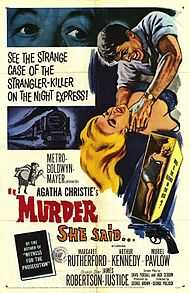Murder, She Said
| Murder, She Said | |
|---|---|
 | |
| Directed by | George Pollock |
| Written by | David D. Osborn |
| Based on |
4.50 from Paddington by Agatha Christie |
| Starring |
Margaret Rutherford Arthur Kennedy Muriel Pavlow |
| Music by | Ron Goodwin |
| Distributed by | Metro-Goldwyn-Mayer |
| Release dates |
|
| Running time | 87 minutes |
| Country | United Kingdom |
| Language | English |
Murder, She Said (1961) is a murder mystery film directed by George Pollock, based on the novel 4.50 from Paddington by Agatha Christie. The production starred Margaret Rutherford as Miss Marple along with Arthur Kennedy and Muriel Pavlow, and features Rutherford's real life husband Stringer Davis.
MGM made three sequels, Murder at the Gallop, Murder Most Foul and Murder Ahoy!, all with Rutherford starring as Christie's famed amateur sleuth.
Plot
While passing by on a different train, Miss Marple witnesses the strangling of a young woman in the opposite carriage. The local police dismiss her story as the ramblings of a senile and bored old woman, so, undaunted, she conducts her own investigation, and comes to the conclusion that the body must be buried on the grounds of Ackenthorpe Hall, which adjoins the railway line.
Wheedling her way into a job as housemaid there, Marple copes with the pompous machinations of her difficult employer, Luther Ackenthorpe (James Robertson Justice), so she can search for the mysterious corpse, and eventually finds it while supposedly practicing her golf shots.
As she begins collecting suspects, accompanied by her long suffering companion Jim Stringer (Stringer Davis), Miss Marple finds herself faced with an increasingly devious and resourceful killer, who begins casting his shadow over Ackenthorpe's heirs...
Differences from the novel
In Christie's original story, an elderly character called Elspeth McGillicuddy witnessed the murder, not her friend Miss Marple, who was introduced later into the story. Also, in the original story, a young acquaintance of Marple's is sent to pose as a house-keeper at the suspect location, not Marple herself. As with most of her appearances in the role, Margaret Rutherford's flamboyant, comical portrayal of the sleuth was quite different from Christie's languid, passive depiction. The tone of the novel was also changed somewhat; instead of Christie's trademark suspense and underlying darkness, the film relied heavily on light, even whimsical comedy of manners.
The name of the manor house where Marple conducts her inquiries was called Rutherford Hall in the novel, and was changed to Ackenthorpe Hall in the film to avoid comparison with the leading actress' surname. Ackenthorpe, the family name in the film, was changed from Crackenthorpe, in the novel.
Cast
|
|
- Cast notes
- Joan Hickson would later star as Miss Marple in the popular BBC Miss Marple TV series
Reception
Despite Christie's dislike of this adaptation, Murder, She Said received a generally positive response from critics, and maintains an 83% approval rating on Rotten Tomatoes.[1] Almar Halfidason, a critic for the BBC film website, awarded the picture four stars out of a possible five, calling it "delightfully dotty" and "fun".[2]
The film made a profit of $342,000.[3]
References
- ↑ http://uk.rottentomatoes.com/m/murder_she_said/
- ↑ http://www.bbc.co.uk/films/2000/09/28/murder_she_said_review.shtml
- ↑ The Eddie Mannix Ledger, Los Angeles: Margaret Herrick Library, Center for Motion Picture Study.
External links
- Murder, She Said at the Internet Movie Database
- Murder, She Said at the TCM Movie Database
- Murder, She Said at allmovie
- Murder, She Said at Rotten Tomatoes
| ||||||||